Lamiastrum is in the eye of the beholder.
If you want a ground cover that will grow in dry, shady places, Lamiastrum is exactly what you’re looking for. But it also likes sunny, watered places and is nearly impossible to eradicate after it escapes the dry, shady place you put it in. Formal gardeners love it or hate it with few opinions in-between. Foragers just eat it.
In the greater mint family, Lamiastrum galeobdolon (lam-ee-AS-trum ga-lee-OB-do-lon) is a native of southern Eurasia though it is particularly common in Great Britain. In the rest of the world it is commonly found in gardens, landscaping and is naturalized in a few states in North American. Among the places it has escaped cultivation in the United States are Washington, near Seattle where it is an official noxious pest, Northern California, northeast Minnesota, Michigan (including the University of Michigan Herbaium) Maryland, Pennsylvania, New York City, particularly Long Island, Massachusetts and Virginia (Fairfax County.) And to clarify, it is common in England, might be seen in southern Scotland, is found in Wales, and also north and east Ireland. It is also naturalized in New Zealand and Australia. Lower British Columbia is being invaded by L. galeobdolon variation florentium.
In fact let me list where it is native: Iran, Turkey, Azerbaijan, Georgia, Albania, Austria, Denmark, Finland, Sweden, England, Czechoslovakia, Germany, Hungary, Netherland, Poland, Switzerland, Belarus, Estonia, Latvia, Lithuanias, Russia, Ukraine, Bulgaria, Greece, Italy, Romania, France and Spain.
Also called the Yellow Archangle and Silver Nettle Vine, it’s been botanically bounced around. It used to be Lamium galeobdolon, making it a genus kin of Henbit, Lamium amplexicaule. Later it was Galeobdolon luteum. Now it is Lamiastrum galeobdolon, which means … this will not make much sense… Resembles a Lamium covered with a helmet with a fly’s sting… ya gotta love botanists and their attempts at Dead Latin descriptions. It is called “resembles a Lamium” because it looks like a Lamium or one of the Dead Nettle crowd. The helmet part probably refers to the upper flower petal. Where the fly’s sting came from no one knows though one should note “dead nettles” don’t sting. Maybe the red on the flower’s other petal looks like blood from a fly bite.
Depending on who’s writing there are one or two species or more, two or three subspecies or more, or two or three cultivars or more, and that might be relics of all the name changing, botanical egos and the ornamental trade. Herman’s Pride and Variegatum are variations of L. galeobdolon. There are scattered references to Lamiastrum montanum which is called in some places a subspecies of Lamiastrum galeobdolon or in others a species unto itself. It’s a tempest in an herb pot. At any rate, species or subspecies both Lamiastrum galeobdolon and Lamiastrum montanum have a flower spike with whorls of flowers. If it has eight blossoms it is the Galeobdolon. If up to 20 flowers the Montanum… for today at least… There is also a spattering of references to L. florentium, L. flavidum, and L. argentatum which all might be variations of L. galeobdolon. This may be overkill but L. Florentium is considered a variety of L. argentatum which is considered a subspecies of L. galeobdolon. Apparently Florentium and Variegatum are the same species. That is also the one inundating Seattle.
Herman’s Pride likes to clump and has green and silver variegations in the leaves very early in the season. Variegatum is similar to Herman’s Pride but the leaves are completely silver with deep green veins. Appearing to have a metallic finish, the leaves reflect sunlight and sparkle in the shade. Variegatum’s leaves are smaller, more narrow and pointed compared to other forms. While the Lamiastums resemble Lamiums they grow taller and faster and take more sun than the very seasonal Lamiums. Other than the Herman’s Pride variety they also create what appears to be a indefinitely spreading, vining mat, rooting where ever they touch the ground. There are many color variations.
Among several interesting aspect about the genus is deer don’t like to eat it, it can withstand a heavy frost, is extremely invasive, and can produce about 800 seeds per plant. While vegetative reproduction is the most common means ants are attracted to certain oils in the seeds and can carry them more than 200 feet from any seed bearing plant. For seeds to germinate they need to be moist and cool for six months, one reason why they grow well in England and why Seattle is Lamiastrum Ground Zero in the United States. (In Washington it is found in King, Kitsap, Sau Juan and Thurston counties as in the Mount. Baker Snoqualmie National Forest.)
Italy reports in 1985 from Centro CNR Per lo Studio della Chimica delle Sostanze Organiche Naturali c/o Dipartimento di Chimica, Universitá La Sapienza: The aerial parts of Lamiastrum galeobdolon subsp. flavidum two known iridoid glucosides, harpagide and 8-O-acetylharpagide, were isolated, together with a new iridoid diglucoside, 10-deoxymelittoside.
What’s an iridoid? It’s a bitter substance some plants produce to keep from being eaten. I said Lamiastrum was edible, not great. That said, like many close relatives in the mint family the Golden Dead Nettle is used as a green when young. Shoots and leaves are eaten boiled or sauteed in butter.
Green Deane’s “Itemized” Plant Profile: Golden Dead Nettle
IDENTIFICATION: Lamiastrum galeobdolon — Semi-evergreen perennial, evergreen in southern climates. Stems are erect, hairy, square like the mints, and mat forming. Leaves are opposite, pointed, ovate to heart-shaped, one to three inches long and coarsely serrated; silvery with green veins and covered with short, fine hairs. They have a pungent odor when crushed… not exactly pleasant. Basal leaves lave long petioles. Flowers are yellow with brown spots and with a hairy ring inside, blossoms are 2-lipped, hooded, 3/4 in. long and in whorls in leaf axils; flowering June to July.
TIME OF YEAR: In northern climes shoots and leaves appear in spring, non-edible blossoms in June to July. In southern climates young leaves and shoots can be available year round.
ENVIRONEMENT: The Golden Dead Nettle is not fussy. It can grow in dry shady places or sunny watered spots. It thrives best in moist soil with partial shade.
METHOD OF PREPARATION: Young shoots and leaves, boiled or sauteed.

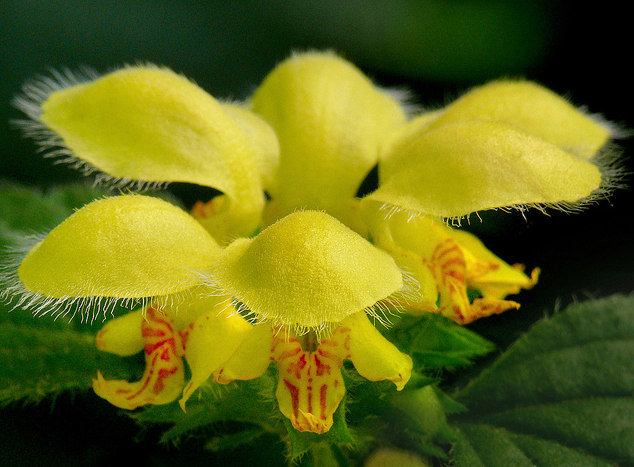
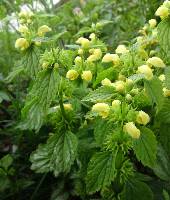
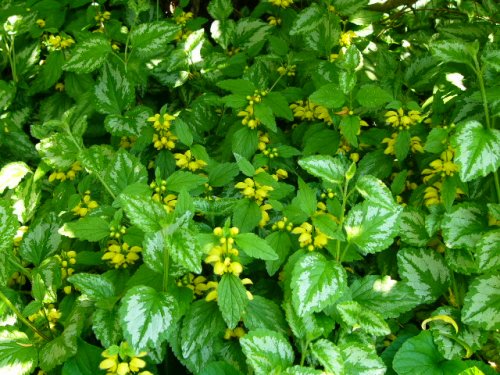
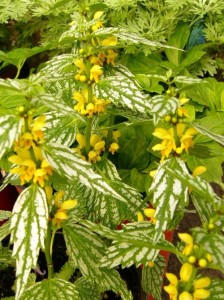
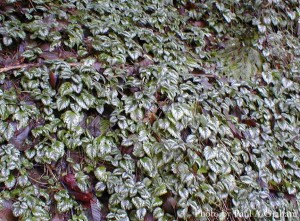

That shot at the top? The close up of the Yellow Dead Nettle? Exquisite. The detail is amazing.
I have two kinds growing in my garden, one has a silver stripe down the green leaf and the other has more of a rounded leaf that is all silver but rimmed around the edges in green. Both have pinkish flours I believe.
Are both edible? I found found references regarding the striped one.
I think one is golden anniversay, spotted dead nettle.
The other looks like Lamium maculatum ‘White Nancy’ Spotted Dead Nettle. Is this one edible?
Love your site btw, and youtube videos! Thank you so much for providing this valuable resource.